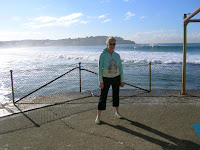 Amy has been busy in Melbourne for the last several days, working on staff in a non-residential Experiential Workshop, Authority, Leadership, Innovation and Collaboration, directed by Professor Susan Long of the Royal Melbourne Institute of Technology (RMIT) University. The workshop provides participants with the opportunity to “explore group, inter-group and organizational dynamics” in the context of a “temporary learning organization,” which has neither set rules nor roles. In other words, hold onto you hats as you enter the vortex to discover things about groups and authority that you didn’t know you knew!
Amy has been busy in Melbourne for the last several days, working on staff in a non-residential Experiential Workshop, Authority, Leadership, Innovation and Collaboration, directed by Professor Susan Long of the Royal Melbourne Institute of Technology (RMIT) University. The workshop provides participants with the opportunity to “explore group, inter-group and organizational dynamics” in the context of a “temporary learning organization,” which has neither set rules nor roles. In other words, hold onto you hats as you enter the vortex to discover things about groups and authority that you didn’t know you knew!Meanwhile Kathy has been completing her lecture series in Sydney and enjoying being introduced to the city’s sights by Vras, whose knowledge of literature and history combined with a great sense of humor provides a uniquely delightful running commentary, while meandering from campus to bookstore to city centre. “Australia is a nation designed by Chekhov,” Vras says, “attentive to detail, sometimes missing the big picture.” The Museum of
 Contemporary Art’s exhibit of aboriginal art has gone traveling and instead we take a quick tour of its permanent exhibits and eat a fine lunch on the terrace near The Rocks, part of the historic district of Sydney.
Contemporary Art’s exhibit of aboriginal art has gone traveling and instead we take a quick tour of its permanent exhibits and eat a fine lunch on the terrace near The Rocks, part of the historic district of Sydney.Wednesday morning, Kathy awoke in time to see sunrise in Sydney and make her way for one last yoga session on Bondi Beach.


An ex-surfer saw Kathy snapping photos and offered to take this one to commemorate Kathy’s last downward dog experience by the surf.
Back to Sydney and ready for her Arendt seminar in the late afternoon (well-received) and then home early enough to pack, Kathy arranged an earlier flight and left for Melbourne around noon the next day. The rain delayed flights but was a much welcome event for Sydney, since all of Australia has been suffering from the biggest drought in the last 100 years.
After one lecture and the end of Amy’s experiential event, we have a day to enjoy the city and walk around Lygon Street, an area with a large concentration of Italian immigrants, one of several populations, including the Chinese, who made their way to this country in the early twentieth century and whose cuisine and aesthetics have shaped the cultural experiences characteristic of this part of the Antipodes. (Immigration continues to be a hot topic in contemporary Australia and the coming elections, some time later this year, will undoubtedly reflect ongoing debates about this and other topics not unlike those in the US.)
A long ride on the #112 tram (accidentally free for us, as we could not figure out the method of payment until after arriving at the destination) took us to St. Kilda’s, one of Melbourne’s historic resort areas and home to the hundreds of penguins and river rats who flock each night to burrow into the rock mounds near the end of the pier, now a nature preserve.
After one lecture and the end of Amy’s experiential event, we have a day to enjoy the city and walk around Lygon Street, an area with a large concentration of Italian immigrants, one of several populations, including the Chinese, who made their way to this country in the early twentieth century and whose cuisine and aesthetics have shaped the cultural experiences characteristic of this part of the Antipodes. (Immigration continues to be a hot topic in contemporary Australia and the coming elections, some time later this year, will undoubtedly reflect ongoing debates about this and other topics not unlike those in the US.)
A long ride on the #112 tram (accidentally free for us, as we could not figure out the method of payment until after arriving at the destination) took us to St. Kilda’s, one of Melbourne’s historic resort areas and home to the hundreds of penguins and river rats who flock each night to burrow into the rock mounds near the end of the pier, now a nature preserve.

We watched the sun set from the deck of the restaurant near the pier’s end and then walked toward the preserve hoping to sight one of these creatures. A small boy pointed out for us the location of one of the penguins, an early arriver nestled in between a stack of rocks so deeply that we had to stare a long time before our eyes adjusted enough to catch a glimpse of a small patch of white fur. Only a few others waited with us on the wintry pier near the sea’s edge, all quiet in the calm of the night. And then a ripple in the water followed by a kind of purring/cooing sound signaled that the creatures were slowly making their way into their burrows. We watched for a little while until the rising wind and brisk, damp air drove us back into the city and after some take away Thai food for dinner and a little reading we were ready for bed.


No comments:
Post a Comment